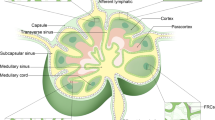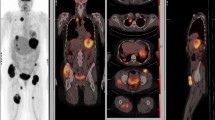Abstract
The sentinel lymph node (SLN) is the initial metastatic site for the majority of solid cancers. In some cases, cancer cells may bypass the SLNs and enter the vascular channels directly to spread to the systemic sites. Metastatic progression is an orderly process. During the process of metastasis, complex biochemical and molecular mechanisms are involved being subjected to the host influence, in particular, the immune system. With more detailed understanding of the genomic and molecular characteristics of cancer both from the primary site and its metastases, the pathways of cancer growth and spread within the cancer microenvironment may be further elucidated.
Similar content being viewed by others
References
Mamam S, Witz IP. Perspectives (2018) A history of exploring cancer in context. Nat Rev Cancer 18(6):359–376
Leong SP, Aktipis A, Maley C (2018) Cancer initiation and progression within the cancer microenvironment. Clin Exp Metastasis. https://doi.org/10.1007/s10585-018-9921-y
Reintgen D, Cruse CW, Wells K et al (1994) The orderly progression of melanoma nodal metastases. Ann Surg 220(6):759–767
Nathanson SD, Krag D, Kuerer HM et al (2018) Breast cancer metastasis through the lympho-vascular system. Clin Exp Metastasis. https://doi.org/10.1007/s10585-018-9902-1
Rios-Cantu A, Lu Y, Melendez-Elizondo V et al (2017) Is the non-sentinel lymph node compartment the next site for melanoma progression from the sentinel lymph node compartment in the regional nodal basin? Clin Exp Metastasis 34:345–350
Leung AM, Morton DL, Ozao-Choy J et al (2013) Staging of regional lymph nodes in melanoma: a case for including nonsentinel lymph node positivity in the American Joint Committee on Cancer staging system. JAMA Surg 148:879–884
Thomas DC, Han G, Leong SP et al (2017) Predictors for melanoma recurrence and the impact of recurrence type on outcomes after a negative sentinel lymph node biopsy. Society of Surgical Oncology Annual Meeting 2017, Poster presentation
Morton DL, Hoon DA, Cochran AJ et al (2003) Lymphatic mapping and sentinel lymphadenectomy for early-stage melanoma. Ann Surg 238(4):538–550
Hirakawa S, Brown LF, Kodama S et al (2007) VEGF-C-induced lymphangiogenesis in sentinel lymph nodes promotes tumor metastasis to distant sites. Blood 109:1010–1017
Karaman S, Detmar M (2014) Mechanisms of lymphatic metastasis. J Clin Invest 124:922–928
Pereira ER, Kedrin D, Seano G et al (2018) Lymph node metastases can invade local blood vessels, exit the node, and colonize distant organs in mice. Science 359:1403–1407
Brown M, Assen FP, Leithner A et al (2018) Lymph node blood vessels provide exit routes for metastatic tumor cell dissemination in mice. Science 359:1408–1411
Naxerova K, Reiter JG, Brachtel et al (2017) Origins of lymphatic and distant metastases in human colorectal cancer. Science 357:55–60
Steuer CE, Ramalingam SS (2018) Editorial: tumor mutation burden: leading immunotherapy to the era of precision medicine? J Clin Oncol 36(7):631–632
Rizvi H, Sanchez-Vega F, La K et al (2018) Molecular determinants of response to anti-programmed cell death (PD)-1 and anti-programmed death-ligand 1 (PD-L1) blockade in patients with non-small-cell lung cancer profiled with targeted next-generation sequencing. J Clin Oncol 36(7):633–641
Simpson D, Ferguson R, Martinez CN et al (2017) Mutation burden as a potential prognostic marker of melanoma progression and survival. J Clin Oncol. https://doi.org/10.1200/JCO.2017.35.15_suppl.9567
Leong SP, Ballesteros-Merino C, Jensen SM et al (2018) Novel frontiers in detecting cancer metastasis. Clin Exp Metastasis. https://doi.org/10.1007/s10585-018-9918-6
Pardoll DM (2012) The blockade of immune checkpoints in cancer immunotherapy. Nat Rev Cancer 12:252–264
Darwin C (1859) The origin of species. John Murray, London
Patel VL, Shortiffe EH, Stefanelli M et al (2009) The coming of age of artificial intelligence in medicine. Artif Intell Med 46(1):5–17
Al-shamasneh ARM, Obaidellah UJB (2017) Artificial intelligence techniques for cancer detection and classification: review study. Eur Sci J 13(2):342–370
Author information
Authors and Affiliations
Corresponding author
Rights and permissions
About this article
Cite this article
Leong, S.P., Zager, J.S. Future perspectives: cancer metastases. Clin Exp Metastasis 35, 559–561 (2018). https://doi.org/10.1007/s10585-018-9920-z
Received:
Accepted:
Published:
Issue Date:
DOI: https://doi.org/10.1007/s10585-018-9920-z




